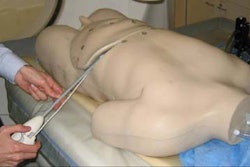The mortality rate in early first-trimester pregnancies with slow fetal heartbeat is relatively high, even in cases in which follow-up ultrasound done within eight weeks shows normal heart rate, according to a retrospective study on the outcome of first-trimester pregnancies.
While earlier studies have shown that the risk of fetal mortality is high when the heart rate is slow, researchers from the department of radiology at Boston's Brigham and Women's Hospital and Harvard Medical School went a step further to show that a fetus with a slow heartbeat at six to seven weeks had an elevated mortality risk even when the follow-up scan showed a normal heart rate, compared to fetuses with a normal heart rate throughout (Radiology, July 2005, Vol. 236:2, pp. 643-646).
"If a (6.0- to 7.0-week) scan demonstrates a slow heartbeat, which indicates a high risk of subsequent demise, a normal heart rate on follow-up scan obtained by 8.0 weeks lowers the risk somewhat but not entirely," the researchers wrote.
Fetuses with slow-then-normal heart rates on follow-up scan had a first-trimester demise rate of 25.4%, compared to 7.2% (p < 0.001) for fetuses with a normal-then-normal heart rate, according to the study results. However, fetuses with a borderline-then-normal heart rate had a first-trimester demise rate similar to those with normal-then-normal heart rates, at 7.6% (p = 0.84) .
Analyses were done using the Fischer exact test, and measurements for slow, borderline, and normal heart beats were made during early pregnancy and between six to seven weeks, with follow-up scans being done within eight weeks. First-trimester outcome was taken to be demise if by 13 weeks cardiac activity had stopped or pathologic exam identified products of conception in tissue spontaneously passed from the mother.
The classifications for slow, borderline, and normal heartbeats are shown in the table below.
|
||||||||||||
| bpm = beats per minute |
Data were analyzed for two groups: 1) the slow and borderline groups as compared to the normal group, and 2) the slow-then-normal and borderline-then-normal groups as compared to the normal-then-normal group. The normal group was the control group for both analyses.
In addition, the research group compared the results from the entire slow group with the slow-then-normal group. The rates of first-trimester demise for the entire slow group was 60.6%, or 188 of 310 pregnancies, as compared to the slow-then-normal group, which had a first-trimester demise rate of 25.4%, or 15 of 59 pregnancies.
In the borderline study group, the rate of demise was 17.4%, or 103 of 593 pregnancies. "All of these rates of demise were significantly higher (p < 0.001) than the rate of 9.1% (186 of 2,034) in the normal group," the researchers wrote. The rate of demise was especially high (77.9%) for fetuses with very slow heart rates or heart rates with fewer than 80 bpm before 6.3 weeks and fewer than 100 bpm at 6.3-7.0 weeks.
The study authors noted that an analyses of the data according to gestational age at initial ultrasound scan at 6.0-6.2 weeks and 6.3-7.0 weeks, and further classifying the heartbeat into very slow and moderately slow at 80-89 bpm (before 6.3 weeks) and 110-109 bpm (6.3-7.0 weeks) yielded similar results.
"In particular when the heart rate early in pregnancy was slow then normal on a follow-up scan obtained by 8.0 weeks, the incidence of first-trimester demise was significantly elevated (approximately 25%), whether the initial slow rate was seen at 6.0-6.2 or at 6.3-7.0 weeks and whether it was very slow or moderately slow (p < 0.05) for all these comparisons, Fischer exact test," the authors stated.
Outcomes of the first-trimester pregnancies were available for 2,937 pregnancies, or 64.5% of cases. So the first set of data analyses was performed for 2,937 pregnancies, of which 310 were in the slow group, 593 in the borderline group, and 2,034 in the normal group.
The second set of data analyses was performed on 567 pregnancies in which the heart rate was measured at six to seven weeks and follow-up measurement was done within eight weeks. In this group, 59 pregnancies were slow-then-normal, 118 borderline-then-normal, and 390 normal-then-normal.
The risk of slow-then-normal fetal heartbeat is more than three times as high as the risk in the normal-then-normal heartbeat group, the authors pointed out.
"It is advantageous to make the diagnosis quickly to avoid the occurrence of vaginal bleeding at an inconvenient time and place, and to minimize the period of concern and uncertainty for the parents," the group wrote.
By N. Shivapriya
AuntMinnie.com contributing writer
August 11, 2005
Related Reading
3D offers speed gains for fetal scanning, July 1, 2005
AMA says ultrasound in-utero "portraits" are bad idea, June 22, 2005
4D ultrasound shows promise for improving fetal echocardiography, April 6, 2005
Copyright © 2005 AuntMinnie.com



















